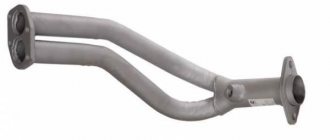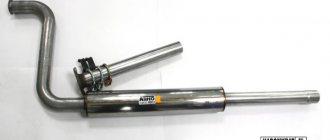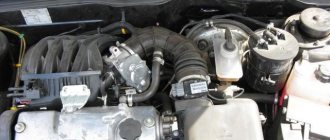Definition and purpose
The muffler resonator is a part of the vehicle's gas exhaust system. Located in the middle part of the chain and designed to extinguish exhaust gases. If the noise is excessively loud, this indicates a problem with the system.
The gas removal chain includes the following links:
- collector;
- gas receiver;
- quench catalyst;
- corrugated pipe;
- resonator.
A correctly assembled system, operating according to its proper principle, dampens almost all sounds from the exhaust manifold. Only a “whisper” is heard, although the temperature in the system reaches 300 º C. The environment is quite aggressive, so it is not so rare to change some parts or even the entire chain.
Types of designs for muffler:
- limiting;
- reflective;
- resonant;
- absorbing.
The resonating one consists of 2 or 3 pipes with holes, which are located in a common body. They create a resonance effect, leveling sound waves and pressure.
In this way, an ideal balance of pressure and resistance in the exhaust pipe is achieved.
The reasons for system failure can be various factors:
- aggressive working conditions;
- metal fatigue;
- corrosion;
- mechanical damage;
- condensate;
- chemical reaction producing acids.
All this can cause a roaring exhaust pipe. Ringing, rattling, drop in engine power due to excessive gas resistance in the system are problems in this circuit.
How to repair a “glushak” with your own hands
The muffler on the “fourteenth” and “fifteenth” is considered one of the most vulnerable points of the car. The fact is that due to exposure to high temperatures, the metal quickly burns out, that is, the tightness of the system is broken. Therefore, the part must be changed as soon as there is a suspicion that it is not working.
Reasons for failure
Most often, mufflers “burn out” - that is, due to hot exhaust, the metal inside the housing begins to thin out, which ultimately leads to the appearance of holes. However, this is not the only reason why the silencer may fail:
using a homemade device - handicraft products do not differ in quality and long service life;
mechanical shocks from uneven roads - dents and deformations of the pipe also lead to loss of tightness;
About the VAZ exhaust system
The simplest exhaust system consists of just a manifold, an intake pipe and a resonator.
It is mounted not only on cars with a carburetor type engine, but also with an injection system (injector) without oxygen sensors. Such vehicles comply with Euro-0 and Russia-83 standards. Oxygen sensors with a catalyst (catal) are installed on cars with Euro-2 injection engines. In common parlance this system is called neutral or catcollector.
In VAZ cars, the catalyst can be of several types:
- an independent detail;
- combined with the receiving pipe;
- combined with a receiving pipe and a collector;
- combined with a resonator.
Models of VAZ-2108-2115 cars from the Lada Samara line are divided into the following types regarding engines:
- Euro-0 – carburetor and injector (from 1.1 to 1.5 l);
- Euro-2 injector (1.5 l);
- Euro-2 and Euro-3 – injector (1.6 l).
The latest, most current 8-valve Lada Samara models according to Euro-2 standards are equipped with a VAZ 181 catalytic collector - 1 sensor. Euro-3 standards stipulate the presence of 2 sensors, so you need a VAZ 183 model of catalytic collector. For 16-valve models - VAZ 186.
How to notice a node malfunction
It is not difficult to determine that it is time to change parts of the exhaust system on a VAZ-2115 with an 8-valve engine.
Even a novice car enthusiast can cope with this, since the main signs are the appearance of a strong smell of exhaust gases in the cabin and an increased noise level. Most often, faults are hidden in the additional or main muffler, as well as in the gaskets between the connections, which can burn out over time. The classification of the most frequently occurring faults is as follows:
- mechanical damage to the muffler;
- burnout of gaskets;
- corrugation burnout;
- loosening of connections at joints;
- cracks in the system pipes.
Problems can be spotted by visual inspection. Experienced specialists recommend removing gas exhaust units for these purposes. This way you can examine them from all sides and notice the slightest damage. After you conduct a visual inspection of the system, you need to buy spare parts and begin repairs. It's easy to do it yourself.
If there are no external problems, you can try replacing the internal resonator. This repair method will only help those who know how to handle welding equipment.
Small burns and holes can be covered with sealant. Just pay attention: it must easily withstand temperatures up to 1000 degrees. Before applying the composition, it is necessary to thoroughly clean and degrease the surfaces.
Self-replacement of the VAZ-2115 resonator: step-by-step instructions
Dismantling a broken system:
- Using wrenches, you need to unscrew both jacks of the clamp mounting bolt. It is preferable to do this with both hands at the same time or with someone's help. This clamp holds the resonator and the rear part of the muffler together.
- After unscrewing, you need to move the clamp a little to the side - onto the adjacent muffler.
- Remove the ring located under the unscrewed clamp.
- In a similar way, unscrew the nuts securing the clamp that connects the receiving pipe and the resonator.
- Remove the clamp completely.
- Disconnect the tip of the receiving tube from the resonator by removing the seal ring that is located between them.
- Use a screwdriver to remove the two hanging cushions. If there is damage to the pillow, it needs to be replaced.
- Only now can you remove the resonator.
- Place the edges of the muffler behind both suspension pads.
- Install the O-ring between the resonator and the rear of the muffler.
- Install a clamp in the place where the sealing ring was previously located.
- Tighten the fastening bolts.
- Place a sealing ring between the exhaust pipe and the resonator.
- Secure the remaining part of the muffler clamp using keys and bolts.
How to replace a VAZ 2115 muffler on your own
We drive the car into a pit or overpass, use a metal brush to clean the bolts on the clamp connecting the muffler pipe to the resonator and unscrew it.
Once the clamp is unscrewed, pull out the O-ring gasket that is located between the connections.
Next, remove the muffler from the rubber pads on which it is suspended. Before installing a new muffler, clean the ring thoroughly; you can even coat the gasket with a heat-resistant sealant, which will allow you to avoid the passage of exhaust gases between these connections.
Assembly is carried out in the reverse order, we hang the new spare part on rubber cushions and connect the resonator to the muffler with a clamp. If other units become unusable, they are changed in the same way.
Diagnostics and repair of muffler VAZ 2114–2115
Every car exhaust system has a muffler, and for many car enthusiasts its purpose is obvious. Driving around the city with a loud and toxic exhaust will be uncomfortable, and fines for exceeding the permissible noise level and harmful emissions from the operation of the car today are quite large. When operating VAZ cars, the muffler is often not given due attention, although it is useful to know how to correctly diagnose the degree of its wear. Timely replacement of the damper is mandatory, since its malfunction can pose a threat to human health and the operation of the car engine.
Removing and installing the catalyst
Removing and installing a catalytic converter on a VAZ 2115 is a relatively simple task. The procedure itself is carried out in several stages:
1. Using keys “17”, unscrew the fastening of the catalyst to the exhaust pipe of the exhaust manifold. We take out the bolts and spring washers;
2. Place a suitable stand under the catalyst. The fact is that the catalyst on the VAZ 2115 car is not fixed with the help of any rubber hangers, and therefore, in order for it not to fall on your head, after unscrewing the fastening bolts, it must be secured somehow. This can be done either by installing a stand under it, or by temporarily securing it with wire;
3. Now unscrew the catalyst from the inlet pipe of the additional muffler and carefully remove it.
We install the new catalyst in the reverse order.
Silencer - purpose, device, operation
An important element of the exhaust system is the muffler; operating a car without it is impossible. As a rule, the muffler is located at the rear of the vehicle and, in conjunction with the exhaust system, serves to remove harmful gases from the engine, bypassing the vehicle interior.
Car mufflers are made from stainless, aluminized and regular black steel. Stainless steel “silencers” are practically not available for sale due to their high cost and long service life (their service life is 10–15 years). Aluminized mufflers are installed on VAZ 2114/2115. They are common in the domestic and European markets (service life 3–7 years). Regular black steel mufflers are cheap substitutes and last only a few months, so are rarely used.
What is a “glushak” for?
Main functions of the muffler:
- reduction of noise during fuel processing;
- reduction in the rate of gas release and their temperature.
The muffler is attached with special rubber pads to curved metal hooks, softening vibrations from the car exhaust
All elements of the exhaust system are exposed to high temperatures, so the coating (anti-corrosion paint, mastic) that is applied to the muffler burns out. The exhaust system of the VAZ 2114/2115 is mounted under the body on the bottom of the car.
An additional muffler or, in other words, a resonator is designed to eject burnt gas into the exhaust pipe and receive the next portion.
The resonator is an important part of the exhaust system; it directly affects engine power. The faster the exhaust gas is removed from the resonator, the faster and more power the car develops.
The design of the pipe consists of all the necessary elements, therefore, when exhausted, the exhaust gas is correctly distributed throughout the exhaust pipe
The muffler on the VAZ 2114/2115 is attached to the bottom of the car with special rubber bands, clinging to flat hooks on the side and top. Why is an elastic band used, and, say, not a metal fastener?
As exhaust gases pass through the exhaust pipe, vibrations intensify, the muffler begins to vibrate, and if the mount is solid-state, the vibration will be transmitted to the cabin. The rubber muffler mount softens vibrations and is therefore used on all cars.
For the VAZ 2114/2115, the muffler is a volumetric sealed metal chamber, divided inside by various partitions. The entire exhaust gas flow passes through the muffler sections and is finally extinguished and cleaned. If you look at the muffler diagram, it will look almost the same on all cars.
OUR CENTERS ON THE CITY MAP
Do you want to inexpensively buy and replace a muffler resonator for a VAZ 2115? "MSK Silencer" - urgent replacement of Lada 2115 resonators with a 1-year warranty.
What is a muffler resonator?
The resonator is a closed metal module with perforated partitions, the main function of which is to slow down the speed and reduce the pressure of the exhaust gases.
As a result, acoustic pollution of the surrounding space is reduced. The resonator chambers are offset relative to each other, which makes it possible to level out strong gas pulsations, increasing the service life of the exhaust system and the engine as a whole.
Causes and symptoms of VAZ 2115 resonator failure
The main reason for the failure of the resonator is a heavy load on the infrastructure from the inside (high temperatures and pressure) with the influence of external factors (moisture, reagents, cold, etc.) from the outside.
Being under such a double attack, this device often fails, which requires qualified repair work. A malfunction of the muffler resonator can be determined by the following symptoms:
- increased noise when the engine is running;
- metallic rattling in the corresponding section of the exhaust system;
- reduction in engine power due to strong pulsation of exhaust gases
If you want to know how much it costs to replace a resonator, check out our price list published on this website. It is worth noting that repair work in this category can often be complicated by the presence of other exhaust system faults discovered during the preliminary diagnostics.
We are ready to eliminate any defects by purchasing the necessary parts ourselves. As a result, you will receive a car with a fully functional muffler, the characteristics of which correspond to the standard parameters.
“Doctor Silencer” is a network of specialized service stations for professional replacement of VAZ 2115 resonators. Service stations are located in all districts of St. Petersburg.
Signs of a resonator malfunction: decreased engine power, unusual sounds (popping, ringing) under the body, the smell of exhaust gases in the cabin. It is possible to repair the resonator if the areas of damage (burnouts, cracks, corrosion) are small. But more often a faulty resonator has to be replaced.
We offer options for replacing the Lada 2115 resonator:
- replacement with a new standard resonator,
- replacement with a new universal resonator.
It is profitable to replace the VAZ 2115 resonator with us:
- Experienced, competent mechanics and professional diagnostic equipment will quickly diagnose and determine the cause of the resonator malfunction.
- Careful replacement, welding in neutral gases followed by anti-corrosion treatment.
- If necessary, we will replace the exhaust system hangers.
By contacting us to replace the resonator, you will receive correct operation of the exhaust system for a long time at a low price.
Replacing a muffler on a VAZ 2115 is not at all as simple as some people think. This will require time and a lot of money. But you can always independently carry out such a pleasant procedure as replacing the muffler of a VAZ 2115. The owner himself will decide what type of this part to install and will monitor the process with his own eyes. The muffler is one of the car parts that attracts the most attention. Although it is located under the car, being the main element of the exhaust gas cleaning system, a lot of effort and time is devoted to tuning it.
Replacing the muffler on a VAZ 2114/2115
Muffler failure on a car can happen for various reasons:
- mechanical damage;
- influence of atmospheric and mud precipitation;
- burnout of the internal elements and walls of the muffler.
Signs of a malfunction most often manifest themselves in increased exhaust sound: the car is very loud, rumbles, an abundance of exhaust gases appears from under the car in the muffler area and the smell of unrefined fuel.
How to change the "glushak" with your own hands
In many cases, the muffler cannot be repaired and requires urgent replacement. This is not as difficult to do as it seems. You will need:
- new muffler + repair kit (rubber cushions, corrugation, metal-graphite ring installed under a clamp at the junction of the pipes of the additional and main mufflers);
- tools;
- portable lamp;
- inspection hole or jack;
- two hours of free time;
- hands growing from the right place.
The repair kit consists of 5 rubber pads, two clamps and O-rings, a gasket
It is recommended to purchase replacement parts from trusted suppliers, as otherwise you may stumble upon a low-quality fake.
After purchasing parts, you need to make sure that they are actually suitable for replacement. You need to check all fasteners, holes and bends.
If all of the above corresponds to the parameters, you can begin dismantling the broken muffler. After installing the car on the inspection hole, check the condition of the fasteners and connecting bolts of the clamp between the additional muffler pipe and the main muffler pipe.
How to remove the muffler
It is recommended to dismantle the unit in the following sequence:
- Before unscrewing the nuts, treat the threads with WD-40 or rust remover and wait 10 minutes.
- Using a socket wrench or a 13mm socket, unscrew the two nuts holding the clamp.
- After removing the clamp, remove the sealing ring.
- Remove the rubber pads holding the muffler.
- Disconnect the muffler from the resonator.
If you have difficulty unscrewing the nuts, you can use a hammer and chisel. To do this, you need to rest the chisel against the edge of the nut and, with sharp blows of the hammer counterclockwise, try to “knock down” the thread. Otherwise, you should cut the bolts with a grinder.
Installing a new part
Installing a new muffler is done in the reverse order, but it is necessary to lubricate the gasket ring with high-temperature sealant. This will ensure a reliable and tight connection.
Video: how to replace a broken plug using tools and an inspection hole
If there is no inspection hole, you can use a jack after placing a stop under the front wheels.
Replacing an additional muffler
As practice shows, the additional muffler fails (“burns out”) much less often than the main one. Nevertheless, this happens, and therefore we consider it necessary to describe the process of replacing it. To complete this work we will need two keys for “13” and two keys for “17”.
First of all, unscrew the bolts securing the resonator to the catalytic converter. We pull out the bolts and disconnect the pipes.
Then we need to disconnect the additional jammer from the main one. To do this, unscrew the two bolts of the tightening clamp using two “13” keys. Remove the clamp and disconnect the pipes. Next, lifting the resonator, remove it from the rubber cushion and pull it out from under the car. If manually removing the muffler from the rubber clamps is problematic, pry them off with a screwdriver.
Repair of muffler VAZ 2114/2115
Before replacing the muffler, it is necessary to inspect it for damage. In some cases, you can get by with minor repairs and not spend money on buying a new part. Restoring the performance of the muffler is carried out according to the following algorithm:
- The muffler and weld seams are cleaned with emery cloth.
- The entire part is inspected for cracks, burns, and damage.
- If a defect is detected, use semi-automatic welding and weld the cracks. A metal plate with a thickness of at least 1.5 millimeters can be welded onto the burnout areas. Seal small cracks with high-temperature sealant.
All working areas must be sanded for a better result.
How to change the resonator on a VAZ
After 99 thousand km.
An extraneous sound appeared from the muffler, a sound similar to the exhaust of a tuned nine. I thought that the resonator or muffler had burned out and holes appeared. As it turned out, in fact, the muffler resonator pipe burst. It was urgently necessary to change it. It was possible to simply get by with cold welding, but this has already been done before me, and the gap is very large. If your pipe bursts for the first time, then weld the fracture using cold welding. So what we have:
- VAZ 2114 1.5l.
- Broken resonator pipe.
What we need to replace:
- Overpass.
- Bricks, boards.
- New resonator.
- Connecting ring (O-ring).
- New resonator gasket.
- New fastening (bolts and screws).
- WDshka.
Reasons for part failure
The muffler is affected by several different factors that can lead to failure, these are:
- Atmospheric precipitation, dirt. Precipitation means the occurrence of rain and snow. A mass that periodically falls on a hot pipe causes temperature changes, destroying the strength of the metal. Unfortunately, it will not be possible to protect the muffler in any way; moisture will in any case affect the metal. A smart solution would be to avoid driving through deep puddles and drive slowly on contaminated sections of the road. If the muffler and pipe are dirty, it is necessary to clean it with water (you can use a pressure jet from a hose). After cleaning, it is recommended to start the engine so that any water that has entered the muffler evaporates.
- Condensate. When the unit is idle for a long time, condensation forms in the muffler, causing a corrosive process. This leads to inevitable destruction of the internal parts of the muffler. This happens extremely rarely, but before the trip it is recommended to increase the operating speed by pressing the accelerator several times. The flow of exhaust gases removes moisture from the silencer.
- Chemical influence. As a result of the release of exhaust gas, a lot of toxic chemical particles settle on the walls of the muffler, destroying the metal, and allowing road reagents to get into the muffler.
- Physical influence. Hitting stones and blows from the muffler when driving on roads also lead to a lot of damage.
The chemical and physical effect on the muffler metal is a natural process. It will not be possible to disassemble and clean the muffler, since the container cannot be opened, and only the attention and professionalism of the driver on the road will help protect it from impacts and stones. Diagnosing and repairing minor damage at the initial stage will help avoid serious problems in the future.
The influence of various negative factors can lead to damage to the corrugation or other parts of the muffler










